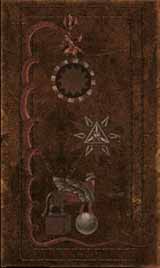
 |
Cards 1 and 2 stand for the First Law of Motion:
1 = The Inertia
2 = The moving force
Cards 3, 4 and 5 stand for the Second Law of Motion (F=ma)
3 = The Power
4 = The Mass
5 = The Acceleration
Cards 6 and 7 stand for the Third Law of Motion
6 = action (or force)
7 = reaction (or opposing force)
|
I often hear the Newton Spread is 'complicated' - in my eyes, it is not.
Guess the catch is to see the Newtonian laws more 'philosophical' but plainly
physical, when after all, we're human beings and not just lifeless physical
objects. I surmise the main difficulty in here lies in the first pair of cards
(1 and 2) representing Newtons first law of motion. For a lifeless object, it
can be perfectly okay to remain in inertia - for a human being it isn't. We
live, therefore we need to act, anything else would mean stagnation.
With this consideration, the spread simply sets the precondition that the
inertia IS acted upon by a moving force - and takes the second card of the
first pair as granted, as something that IS.
Newton's first law of motion (also known as the law of inertia) states that any
object in a state of rest or of uniform linear motion tends to remain in such a
state unless acted upon by an external force.
Card 1 is your inertia, the potential inside you that won't act up or get
effective without another force or impulse that will bring it into activity.
Card 2 is that other force or impulse that will bring the existing power inside
of you into action.
Newton's second law of motion establishes a relationship between the power
applied to an object and the resultant acceleration of the object. This
relationship states that an power acting on an object produces an acceleration
that is in the direction of the power, directly proportional to the power, and
inversely proportional to the mass of the object. In other words, power equals
mass times acceleration, or F=ma.
Card 3 represents your power, your best potential; or that what currently is
the most weighty - good or bad.
Card 4 is the 'mass' i.e. the raw massive precondition for the power of card 3
- you can take it as the 'passive' part.
Card 5 is the 'acceleration' acting upon the 'mass' to make the power of card 3
effective - you can take it as the 'active' part.
Newton's third law of motion (also known as the principle of action and
reaction) says that every action (or force) gives rise to a reaction (or
opposing force) of equal strength but opposite direction. In other words, every
object that exerts a force on another object is always acted upon by a reaction
force.
Card 6 is your action, while card 7 is the direct reaction that your action
provokes or activates. When you call out, you will receive an echo.
Now you can display your cards here.
As you see, the cards in the Shuffle Window have their numbers on their backs,
so it is easy to choose the right ones from the dropdown lists. Just take care
you have them in the right order.
Inertia

|
Moving Force

|
|
The Power

|
The Mass

|
The Acceleration

|
|
Action

|
Reaction

|
|



